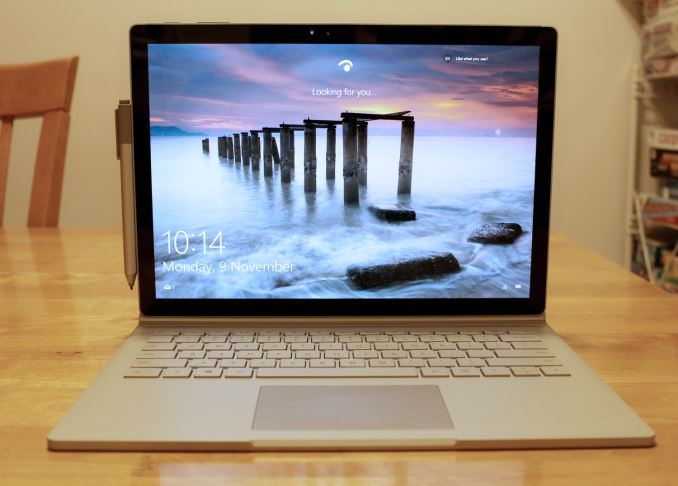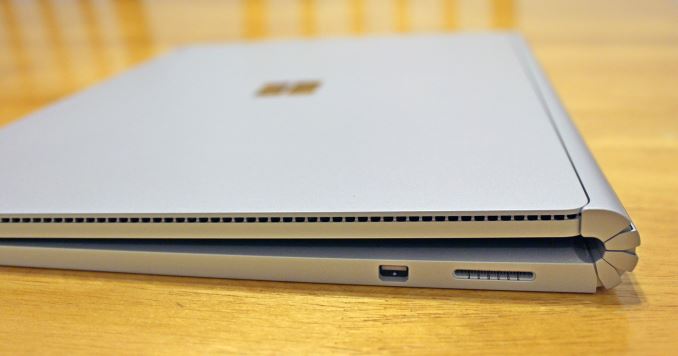The Microsoft Surface Book Review
by Brett Howse on November 10, 2015 8:00 AM EST
When Microsoft first launched the Surface Pro, they decided to tackle a market that was pretty much untested. Sure, tablets had been around for a while already, but no one had packed a full Ultrabook inside of a tablet. True, the initial Surface Pro had some compromises made due to the hardware available at the time, but Microsoft started to build a brand with Surface, a brand that they lifted from another product line altogether. It’s taken a few generations for the hardware to catch up with that original vision, but I think it’s fair to say that the Surface Pro tablet line has solidified itself as the Windows tablet to beat. The build quality, materials, and performance, are really second to none at this time.
I’m talking about branding because it’s one of the most difficult parts of a new product lineup. Microsoft, perhaps more than most companies, has certainly had its struggles with branding over the years. Surface though, has truly been defined, and molded, and evolved, into a strong brand for the company, and it plays right at the high end. And that brings us to Surface Book. Surface Book is an extension of the Surface brand, and Microsoft now wants to try its hands at the laptop market. Their goals for Surface Book are certainly not the same as they were for the original Surface Pro, since the laptop market is already well defined, and there are already many excellent devices available. For Microsoft to throw their hat in the ring in this segment is a much different proposition than before, and to succeed, as well as to continue to evolve the Surface brand, they set out to build what they are calling “The Ultimate Laptop”.
Surface Book certainly keeps the tradition of Surface alive and well. The 13.5-inch laptop has the same 3:2 aspect ratio of the rest of the Surface line, and it is built out of magnesium with the same finish. The fit and finish is very high, and the entire device feels as premium as it should. I think the defining feature of the Surface tablet lineup is the kickstand, and with the Surface Book it is most certainly the hinge. The hinge on the Surface Book is truly unlike anything ever used on a notebook computer before, and while it may not be to everyone’s taste, it certainly draws comments. The hinge, other than a design element, brings a lot of function to the party as well, with it being a key component to keeping this laptop balanced correctly. Balance is generally not an issue with laptops, but the Surface Book has another trick up its sleeve – the display detaches. The Surface Book is hardly the first device to do this, but it is one of the few that has tried to tackle the balance problem with 2-in-1 devices where the screen detaches, and the hinge is a key component to that. Microsoft calls it a Dynamic Fulcrum Hinge, and it extends the base of the laptop slightly to give it more leverage over the display section.
The design is unique, and what is inside is unique as well, at least potentially. There are two models of the Surface Book. The first model is a typical Ultrabook inside, with an Intel Core i5-6300U processor, but the second model is the only detachable laptop which also has a discrete GPU. There are a couple of reasons this has never been done before, with the main reason being it’s very difficult to dissipate the extra heat that a GPU brings to the table. Microsoft has designed the Surface Book with a GPU which lives in the keyboard base, with the rest of the required components behind the display. This gives them two thermal zones, and by moving the GPU to the base like this, it lets the Surface Book cool the CPU and GPU independently. The extra space in the keyboard is then packed with batteries.
| Surface Book | |||
| Core i5 | Core i5 w/GPU | Core i7 w/GPU | |
| GPU | Intel HD 520 | Intel + "NVIDIA GeForce" (Approx. GT 940M) w/1GB GDDR5 |
|
| CPU | 6th Generation Intel Core i5-6300U (15w) | 6th Generation Intel Core i7-6600U (15w) | |
| Memory | 8-16GB RAM | ||
| Display | 13.5" IPS 3000x2000 resolution 1800:1 Contrast Ratio 100% sRGB, individually calibrated 10 point touch and Pen support |
||
| Storage | PCIe 3.0 SSD 128 GB to 1 TB | ||
| I/O | USB 3.0 x 2 (In Base) SD Card reader (In Base) Surface Connector (In Tablet and Base) Headset Jack Mini DisplayPort |
||
| Dimensions | Laptop (mm) : 232 x 312 x 13.0-22.8 (inches) : 9.14 x 12.3 x 0.51-0.90 Tablet Only (mm) : 220.2 x 312.3 x 7.7 (inches) : 8.67 x 12.3 x 0.30 |
||
| Weight | Laptop 1.515 kg / 3.34 lbs Tablet Only 726 g / 1.6 lbs |
Laptop 1.579 kg / 3.48 lbs Tablet Only 726 g / 1.6 lbs |
|
| Camera | Windows Hello (Front) 8 MP Rear Facing 5 MP Front Facing |
||
| Price | $1499+ | $1899+ | $2099+ |
Looking at the specifications, one thing to point out is the battery capacity. Most Ultrabooks would average somewhere around 50 Wh of capacity, with a few somewhat higher and a few somewhat lower. By combining the battery in the tablet, which Microsoft calls the Clipboard, with the base, the Surface Book has an amazing 70 Wh of battery capacity. This should help out on battery life, assuming the 3000x2000 display doesn’t drag that down. The rest of the Surface Book is pretty similar to the Surface Pro 4, with PCIe NVMe storage options up to 1 TB, and touch and pen support via the PixelSense display. There are also two USB 3.0 ports in the base, along with a DisplayPort output, and the Surface Connect port which is used for charging, as well as connecting the Surface Dock. There are no ports on the Clipboard at all, with the exception of the Surface Connect port, so if you are using the Clipboard on its own, you will have to dock it to access USB. Like the Surface Pro 4, it would have been nice to see a USB Type-C port included, and the Clipboard would be a perfect spot for that.
Microsoft is calling the Surface Book “The Ultimate Laptop” and that is a pretty lofty goal for a first generation product. In this review, we will examine all aspects of the Surface Book and see how they compare to the best laptops around. Let’s start with the design.











249 Comments
View All Comments
nerd1 - Tuesday, November 10, 2015 - link
Surface book has surprisingly good cooling. I did prime95 test myself for 30 mins and CPU clock was around 2.8Ghz. Slightly less than full turbo, but still impressive for 7.7mm thin device. Spectre x360 lasts ~12 hours with 52Wh battery, so it makes sense this HiDPI machine lasts ~12 hours with larger 70Wh battery.And face it, anandtech is not really interested in anything non apple. I have recently seen a side-by-side blind test of 6 smartphone cameras and iPhone 6s+ one was very obviously the worst in all possible situations. And AT called iPhone 6s "the best phone ever". LOL.
s.yu - Wednesday, November 11, 2015 - link
This should be the 11th review on the MSB I've read. The battery life varies greatly between reviews and I've seen 4 6-7hrs claim, 2 10-11hrs claim and 5 12-15 hrs claim including this one (in fact the 15hrs it got out of the i5 model is the longest I've read about, it was mostly 12-13hrs). I think it's just that there are still many problems with the software, and if not solved, you could get 2.5hrs minimum just surfing the web (single case of customer feedback) with the keyboard attached.nerd1 - Wednesday, November 11, 2015 - link
Personally i could achieve 9-10hrs with office jobs and chrome, and 14 hrs with edge.nyonya - Tuesday, November 10, 2015 - link
Any chance of redoing the Surface Pro 4 battery life tests post - firmware upgrade?vinsanity - Tuesday, November 10, 2015 - link
Which Surface Pro 4 was in these benchmarks??lilmoe - Tuesday, November 10, 2015 - link
I like the Surface Book. I think it's a GREAT laptop. But I won't be buying one because I'm probably not the intended audience. I need my Quad Core CPU.The thing that really got my interest was the internal design. No the part where the screen comes off, but the part where the battery is behind the screen. It really was like a eureka moment.
Microsoft's implementation has it that the batter in the clipboard is high, with a higher center of gravity relative to the hinge. They were forced to do so because they need space for the "muscle wire" mechanism. BUT conventional laptops don't need that mechanism.
Having all or part of the battery behind the screen is such a brilliant design idea. Especially since LCD panels are extremely thin nowadays. It removes a huge strain on the internal design of a laptop, and leaves more area for active/hybrid cooling and other peripherals, while remaining relatively thin. Not necessarily lighter, but considerably thinner designs with significantly more room for much larger battery (and possibly more circuitry) behind the screen.
NOW, I want a conventional, thin, high performance laptop with a beefy processor and GPU, and a lid that adds more battery behind the screen towards the bottom (to lower the center of gravity of the lid and make the device more balanced). The lid would be a tiny bit thicker on the bottom and tapers along the top (like a macbook air for the lid only).
This design would be great for think, stylish mobile workstations and gaming laptops.
MattL - Tuesday, November 10, 2015 - link
Good review, fair criticismsbluevaping - Tuesday, November 10, 2015 - link
One of the best thing for Surface Book is fast storage. The most powerful notebook this size that is great for League of Legends or Dota 2. Ok for $1899? Give me an Elitebook 14" 745 G3 for $919+ and install $350 PCIE 512GB. $1269. They both are about 3.4 pounds. Can the Elitebook run Dota 2 with twice the storage, Yes.s.yu - Wednesday, November 11, 2015 - link
That's not very fast. RAID0 gets you twice that speed. Don't forget you could get the bad straw and end up with an even slower drive.mmrezaie - Tuesday, November 10, 2015 - link
I don't understand why anyone should be bothered with this because of all the privacy issues. According to our tests it is actually abiding the claims they made by gathering even contents of my disks and uploading them to some ip address held by microsoft.